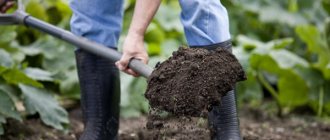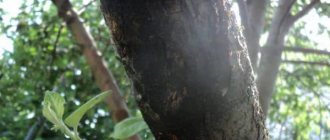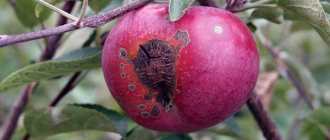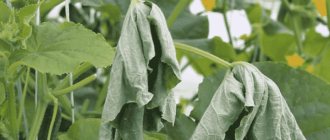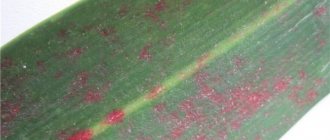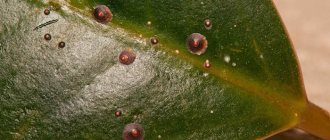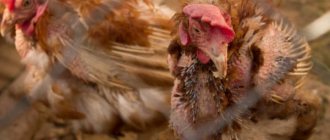Conditions for the development of the disease
The virus requires favorable conditions to activate. It starts working when:
- sudden changes in temperature;
- warming above 25 ⁰С;
- cold night.
A dormant virus awakens. The disease affects cucumbers. The infection is spread by:
- weeds;
- contaminated soil;
- dirty gardening equipment and gloves;
- seeds of a diseased plant (using your own material);
- aphids and sap-sucking insects;
- wind carrying the remains of diseased plants.
Timely disposal of cucumber vines, leaves, disinfection of soil and equipment will help reduce the risk of infection.
Plant leaves should be inspected regularly. There are several types of mosaics. A common feature: greenhouse plantings get sick, cucumbers in open ground are sometimes damaged.
Tobacco mosaic
This virus (TMV) is the most common. It affects nightshades and rarely cucumbers. It is easy to recognize the threat: you should carefully examine the plants. Signs:
- beige stains appear on the leaves of cucumbers;
- the green parts become blistered;
- the plates dry out and die;
- the fruits become ugly and change color.
The ovaries fall off. The number of fruits decreases. TMV lives in the ground for 5 years. Before opening, completely destroy tobacco plantations. Today, a gardener can protect cucumber beds.
The insidious CMV virus
CMV causes the disease common mosaic. Affects young greenhouse plants. It is easy to determine the onset based on the symptoms. The condition of the leaves should be assessed:
- the plates become marble in places;
- the color of the affected leaf successively changes to light green, dark green, yellowish;
- the edges roll down;
- the distance between the plates decreases;
- leaves become smaller;
- the plant slows down;
- the ovaries fall off;
- the plant stem cracks lengthwise (in severe cases).
The lesion has a mosaic structure. The scale of the disease depends on the resistance of the variety or hybrid, climatic conditions (humidity and temperature in the greenhouse), and the degree of neglect. There is no treatment for mosaic on cucumbers. The gardener should prevent infection when planting.
See also
Planting, growing and the best varieties of cucumbers for a polycarbonate greenhouse in the Moscow regionRead
Cucumber disease in greenhouses and soil necrosis: photos, videos and control measures
We should start describing cucumber diseases with mosaic viruses, which are widespread in various types of greenhouses. Their occurrence and development are significantly influenced by the growing conditions of the crop; with sudden changes in soil and air temperature, the harmfulness of the viruses increases, and the symptoms of the disease become more pronounced. Thickening of cucumber plantings also leads to an increase in mosaic diseases.
Green mottled or English mosaic. The causative agent of this disease of cucumbers in greenhouses is the green mottled mosaic virus, or it is also called “cucumber virus 3.”
We invite you to familiarize yourself with DIY crafts gifts of autumn for school
The virus mainly affects young plants, causing leaf deformation. Later, plant growth stops and they die prematurely. Symptoms appear on young plants 20-30 days after planting seedlings in a permanent place, provided that the temperature rises sharply to 30 ° C.
The set fruits develop slowly, become deformed or become mosaic in color, and their quality deteriorates.
White mosaic. This is an even more harmful strain. On young growing leaves, clearings, yellow rings and star-shaped spots form along the veins, which, growing rapidly, become white. Subsequently, the entire leaf blade becomes completely white. The same picture is observed on the fruits themselves. This virus can infect cucumber, melon and watermelon.
Moreover, provided that the seeds are a source of infection, the first signs of the disease appear within two weeks after planting the seedlings in the ground, and after 40 days the disease takes the form of epiphytotics.
If the source of the disease is plant debris, then the first symptoms can be detected after 20-30 days. Viruses are stored for a very long time.
Control measures. Due to the fact that the virus is very persistent, the seeds cannot be heated. You only need to purchase virus-free seeds.
In film greenhouses, when identifying affected plants, you can use the following method of treating this cucumber disease: lower the cucumber stems and cover them with loose soil, which will promote the growth of the root system. Then you need to feed twice with Extrasol solution or a solution of chicken manure diluted 1:15 or mullein (1:8).
Ordinary mosaic. The causative agent of this disease is the cucumber mosaic virus. The first signs of the disease appear on seedlings in the form of mosaic, zonal chloroticity, curvature and wrinkling of leaves. As the disease progresses, the leaves wrinkle, the edges turn down, and they acquire a mosaic coloration. Plant growth slows down, internodes are shortened, the number of flowers and leaf area are reduced.
At low air temperatures, cucumber fruits also acquire a mosaic color, wrinkle and bend. Sick plants may wilt, flowers dry out, and the stem becomes glassy.
Control measures. Getting rid of weeds in the greenhouse area and from close placement of pumpkin crops.
The use of disinfected substrates using drugs such as Farmayod, Alirin, Gamair and Extrasol.
After reading the description and methods of treating these cucumber diseases, do not forget to sow only disinfected, virus-resistant seeds, and constantly fight against aphid vectors.
Viral necrosis of cucumbers is a very harmful disease that affects almost all vegetable, as well as fruit, berry and flower and ornamental crops.
Symptoms of this disease of cucumbers in open ground and greenhouses appear first on the leaves in the form of small brown spots and stripes located along the leaf veins. Often the entire leaf is covered with such spots, and it dies. Many small light depressed spots with a dark green border are formed on the fruits.
This is especially clear during periods of low light.
Measures to combat this disease of cucumbers are only preventive:
- removal of diseased plants;
- steaming the soil or replanting in the same place no earlier than a year later. If you plan to plant a cucumber after a tomato, then the soil does not need to be steamed.
To prevent and prevent this disease of cucumbers in greenhouses and open ground, it is also necessary:
- grow resistant varieties and hybrids;
- carry out preventive vaccination of seedlings;
- remove diseased plants after a month or at the first detection;
- destroy vectors of infection;
- fight weeds in greenhouses and adjacent areas;
- maintain spatial isolation from infection reservoirs;
- use seeds for sowing after long-term storage of 2-4 years, during which time the viruses lose their harmfulness;
- if there are no long-term storage seeds, they can be freed from viruses by heating;
- It is advisable to carry out thermal disinfection of dry seeds from viruses using special thermostats, which is not available to every vegetable grower.
Downy mildew is a very harmful disease of cucumber leaves, affecting them both in open and closed ground.
Downy mildew, or downy mildew, appears on plant leaves initially in the form of irregularly shaped watery spots that quickly turn yellow. If the weather is humid, a characteristic gray-violet or even black coating forms on the underside. In dry conditions there is no plaque.
The disease appears on leaves at an average daily temperature in the range of 18-22 ° C in the presence of drops of water, or dew, or fog for 8 hours. These are the “critical days” - a kind of “fire”, during which fungi form the maximum number of spores and massively infect more and more new plants.
To treat this disease of cucumbers in greenhouses and open ground, the following measures should be taken:
- agrotechnical - ensuring optimal air and water humidity conditions;
- seeds and seedlings should be treated with the microbiological preparation Extrasol, 1 tablet of Glyokladin should be added to each plant, which can eliminate many root rots and fusarioses of cucumber;
- use biological products Alirin-B and Gamair, 1 tablet each, diluting them in 10 liters of water against powdery mildew and downy mildew with an interval of 9-12 days. When the first symptoms of the disease appear, treat every 5-7 days.
- For the treatment and prevention of this disease of cucumber leaves, approved chemical preparations are indicated with the addition of Novosil (1 ml) and Extrasol (10 ml) for every 10 liters of water.
- Mandatory destruction of single leaves with disease symptoms is necessary.
This disease is very difficult to treat with copper-containing drugs, and therefore it is necessary to use a drug such as Ridomil Gold, but no more than 3-4 times with an interval of 10 days, reducing its rate by 50%, provided that you add the drug Extrasol to the tank mixture (10 ml/10 l of water), but it is necessary to take into account the waiting period - 3-5 days (the number of days before picking the fruit).
No less dangerous is powdery mildew on cucumber plants, which affects all above-ground parts, but most often the leaves and leaf petioles. Signs appear in the form of a white powdery coating first on the underside of the leaf, and a little later on the top. With early infection and a high degree of damage, this disease of cucumbers in the soil and greenhouse completely covers the plant, and it becomes covered with a white powdery coating and dries out.
We invite you to familiarize yourself with Pear-Shaped Cucumber
Constant use for irrigation (10 ml/10 l of water) and foliar feeding (10-20 ml per 10 l of water) of Extrasol allows you to minimize diseases and reduce the amount of applied mineral fertilizers by 30-50%, since the latter has the ability to transfer accumulated in the soil insoluble residues of mineral fertilizers into forms accessible to plants and transports them to the desired parts of the plant.
To avoid having to take measures to treat this disease of cucumbers in a greenhouse or open ground, take all preventive measures and do not violate agricultural technology, and for planting, purchase varieties that are resistant to both types of diseases. Use the same preparations as for downy mildew, and spray each new pair of young leaves with Novosil (1 ml per 10 l of water) or El-1 (1 ml/10 l of water) with the addition of Extrasol (10 ml/10 l of water) ).
English misfortune
The disease is caused by the CGMMT virus. This enemy is capable of destroying half the crop. Green mosaic affects young and old bushes. Plants in open ground are rarely affected. Signs of infection:
- the leaf color remains green in the first days;
- the shape and texture of the plate changes (tubercles form);
- light veins appear;
- plant growth is inhibited;
- fruits change taste (become bitter);
- cucumbers become shortened and covered with spots;
- seeds do not develop.
The disease will manifest itself a month after planting young cucumbers. Prevention and compliance with the rules of care will help to avoid plant diseases. Biologists call the green mosaic English.
Agrotechnical techniques to help cope with the disease
Agrotechnical practices include:
- If you planted cucumber seedlings in a greenhouse, then you should not plant pumpkins, watermelons, or melons nearby, because they may be affected by mosaic.
- The greenhouse is ventilated in order to make the air in it cooler, that is, below +30 degrees.
- The plantings should not be allowed to thicken, so you should promptly thin out the plants and pull out the weeds.
- Diseased bushes are pulled out and burned.
- It is necessary to frequently wipe all equipment with medical alcohol, a solution of potassium permanganate or a solution of copper sulfate so that viruses are not transmitted from it.
- Soil and tops left on the site can transmit the disease. Because of this, it is worth observing crop rotation.
Concomitant disease
Often, at the same time as green, there is a white mosaic on cucumbers. It is caused by the CV2A virus. It is activated in hot greenhouses and dense plantings. Signs of the disease:
- blurry white-yellow spots appear in the area of the veins;
- then they merge and change color to white-green;
- the leaf blade becomes white or yellow;
- plant development stops.
The virus persists in plant debris, soil, and seeds. The resistance of seedlings to damage increases if the growing rules are followed.
Bacteriosis or angular spot
The causative agent is a bacterium from the genus Pseudomonas. Preserved on plant debris and in seeds. The development of the disease is promoted by high humidity and temperature. It most often affects greenhouse cucumbers. In closed ground, you cannot water the crop with rain, as drops of water on the leaves contribute to the spread of infection.
Description of the disease
The disease affects leaves, fruits and seeds. The disease on cucumbers can appear during the entire growing season, including during the germination phase.
The disease appears on the leaves and then spreads to green plants.
- Yellow angular spots appear on the leaves, which then turn gray-brown and dry out. At this point, the tissue falls out, holes appear on the leaves, and then they dry out. Dull pink droplets of liquid appear on the underside
- Brown ulcers appear on the fruits, which are filled with dirty pink contents. When the liquid dries, a film appears on the surface. In places where spots appear, the fruits become distorted. The infection penetrates into the pulp of the fruit, and from there into the seeds, where it persists until the next season. Greens with angular spotting become inedible. But the disease in dachas, as a rule, does not reach this stage of development.
If cucumbers are not treated, the plants die both in the greenhouse and in the open ground
How to treat bacteriosis
Despite the fact that the causative agent of the disease is of bacterial origin, it is treated with fungicides (antifungal drugs). They are quite effective.
- The most effective against bacteriosis are copper preparations: Kuproxat, Bordeaux mixture, Abiga Peak. The greens should then not be eaten for 20 days.
- Use of the biological product Fitolavin. It belongs to phytoantibiotics (biobactericide) and completely destroys the causative agent of the disease. To prepare a working solution, 2 ml of the drug is diluted in 1 liter of water, the consumption rate is 10 l/100 m2. The solution is used only fresh, it is not stored.
- When feeding, increase the dose of potassium fertilizers or make additional potassium fertilizing.
There are no effective folk remedies to combat bacteriosis.
Prevention
- When the first signs of disease appear on cucumbers, watering is reduced and greenhouses are constantly ventilated. Air humidity should be reduced to 80-85%. The air, soil and plants must be dried.
- Collection and destruction of plant residues.
How to fight a formidable enemy
Viral infections of cucumbers should not be treated with chemicals. When the first symptoms of the disease appear, you need to:
- remove the affected plant entirely or just a leaf;
- reduce the temperature in the greenhouse < 30 ⁰С;
- increase humidity (place containers with water, spray paths);
- disinfect the instrument;
- sprinkle the soil with ash or water with a light pink solution of manganese;
- remove weeds around.
Additionally, you should inspect the area and eliminate anthills. This will stop the spread of aphids. It transmits the infection to healthy plants. Some gardeners remove the soil along with the affected bush. It is replaced with healthy soil. Sick plants should be burned.
It should be remembered: the English mosaic virus is resistant to changes in external conditions. It remains survivable when the temperature rises to 90 ⁰C, freezing, drying.
Restoring favorable conditions in the greenhouse will slow the spread of the disease. To consolidate the result, you need to treat the plantings with serum (1 part to 10 parts water).
Preventive actions
The contagious cucumber yellow mosaic virus is more difficult to cure than to prevent. The task is to inspect the seedlings. The first agrotechnical technique is to eliminate weeds near the plantation. Remove biological residues and traces of the previous harvest. The second agrotechnical technique is that there should be no garbage near the beds. Other recommendations:
- Regardless of the source of origin, seed material is subject to mandatory pre-treatment in a weak solution of potassium permanganate;
- select seeds that are resistant to the pathogen;
- compliance with crop rotation rules;
- a plant with minor signs of disease must be immediately removed and burned;
- the soil near the place where the damaged bush grew is immediately treated;
- Preventive soil treatment against aphids is regularly carried out on the site;
- At the site, they monitor the stability of the temperature regime and the level of humidity.
You may be interested in:
Diseases of cucumbers and their treatment Cucumbers, which we all love, and which every gardener grows, came to us from the tropics, because they need...Read more...
Cucumber mosaic is a viral disease that destroys seedlings. It is carried by aphids. In addition to insect pests, the actions and inactions of the gardener are to blame. The use of contaminated tools or seed, lack of preventive soil treatment - all this increases the risk of infection. Regular inspection of plantings will help minimize the risk. The affected seedlings are immediately removed, and the soil and remaining cucumbers are treated. The viral disease of country cucumbers spreads quickly. Don't hesitate to take action.
